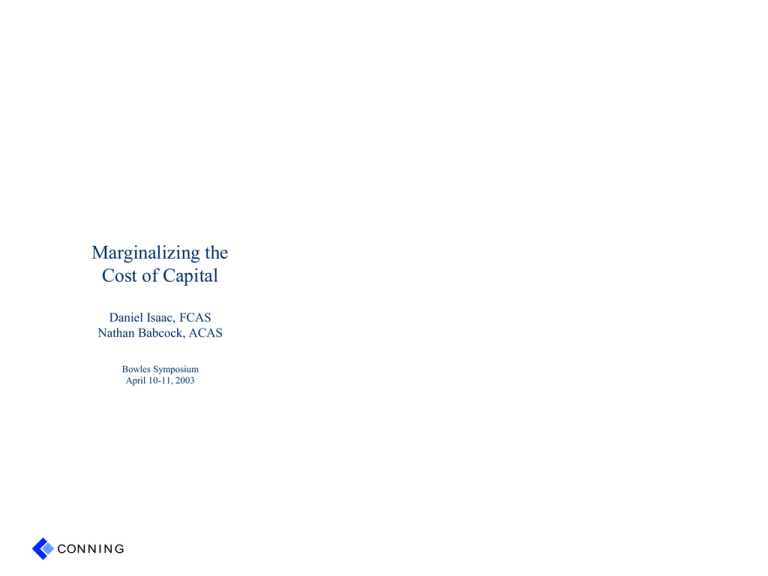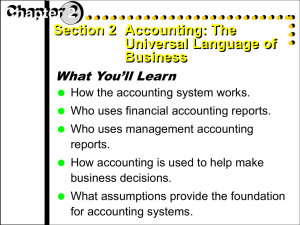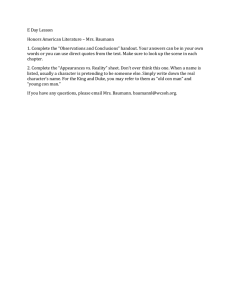Marginalizing the Cost of Capital Daniel Isaac, FCAS Nathan Babcock, ACAS
advertisement

Marginalizing the Cost of Capital Daniel Isaac, FCAS Nathan Babcock, ACAS Bowles Symposium April 10-11, 2003 CON N I N G Cost of Capital Discussion • Most work has focused on “How to Allocate” • First, need to answer “Should We Allocate?” • Economic theory says the answer should be “No” CON N I N G 1 Cost p e r Polic y (Cost of Cap ital + L oss an d E xp e n se ) A v era g e H u rd l e R a te (% = R etu rn / C a p i ta l ) Ave r age L oss an d E xp e n se p e r Polic y Ave r age Cap ital p e r Polic y Why Do We Allocate? N um ber of Policies N u m b e r o f P o lic ie s CON N I N G N um ber of Policies N um ber of Policies A verage M arginal 2 One Big Problem • Decreasing Marginal Cost Monopoly • Insurance industry is very fragmented • Very easy entry - Bermuda CAT companies after Hurricane Andrew - Specialized reinsurers post 9/11 CON N I N G 3 How Do We Address This • Strategy Specific Cost of Capital • Regulatory Costs CON N I N G 4 Strategy Specific Cost of Capital • “Cost of Capital” is the return forgone by Investors • Needs to be related to: - Returns available for other investments - Company’s riskiness - Time horizon • Described in “Beyond the Frontier: Using a DFA Model to Derive the Cost of Capital” from the AFIR Colloquim (2001) CON N I N G 5 Strategy Specific Cost of Capital • Initial Methodology - Determine asset-only Efficient Frontier - Calculate company’s results for selected strategy - Determine “Best Fit” portfolio - This portfolio gives us the strategy’s hurdle rate • Main problem: Creates a maximum hurdle rate - Hurdle rate can’t exceed highest returning asset - Particularly problematic when strategy involves investing in this asset class CON N I N G 6 Strategy Specific Cost of Capital • Proposed Solution: Allow leverage - Combine investment in benchmark with a long or short position in risk-free asset - Shorting eliminates maximum hurdle rate CON N I N G 7 Practical Example • Based on DFAIC - Company “created” for 2001 CAS Spring Forum - See “DFAIC Insurance Company Case Study, Parts I and II” for more details • Consider varying levels of new business - Scaled underwriting results for new business - Scaling ranged from 0% to 300% of baseline - Kept initial surplus and existing reserves the same CON N I N G 8 Practical Example: Results CON N I N G 9 Practical Example: Key Insights • Hurdle rate is positive even with no new business - Investors get paid as long as there is risk - Means timing, not just amount, of Cost of Capital must be considered • Hurdle rate increases with level of business - New business is like “borrowing” from policyholders *Premium “loan” proceeds *Losses and expenses repayments - Economic theory suggests increased borrowing leads to increased hurdle rates CON N I N G 1 0 Practical Example: Key Insights • Marginal cost is positive - Better than traditional approach - Still not increasing CON N I N G 1 1 Practical Example: Key Insights M ar gin al Cost as % of W r itte n Pr e miu m 0.8% 0.7% 0.6% 0.5% 0.4% 0.3% 0.2% 0.1% 0.0% 0% 25% 50% 75% B aseline 125% 150% 175% 200% 250% 300% B usiness G row th Strategy CON N I N G 1 2 Practical Example #2 • Economic theory includes the Cost of “Financial Distress” - Direct: Additional costs associated within liquidating company - Indirect: Lost profits due to reduced business - Indirect much bigger problem for insurers • Revise model to restrict business when capital is inadequate - Maximum premium to surplus ratio set at 3:1 - If surplus is insufficient, future year’s writings are reduced - Reductions are permanent and cumulative CON N I N G 1 3 Practical Example #2 300,000 250,000 Re gu lator y Cost 200,000 150,000 100,000 50,000 0 0% 25% 50% 75% B aseline 125% 150% 175% 200% 250% 300% -50,000 B usiness G row th Strategy CON N I N G 1 4 Practical Example #2: Key Insights • No impact on lowest levels of business • Slight “benefit” at interim levels - Low probability extremely bad results - Serial correlation of results lost business was unprofitable CON N I N G 1 5 Practical Example #2: Key Insights • Rapid increase in costs at highest levels - Higher probability - Loss of expected profitability • Combining with cost of capital creates more traditional cost curve - Initially decreasing - Increasing at higher levels CON N I N G 1 6 Practical Example #2: Key Insights M ar gin al Cost as % of W r itte n Pr e miu m 3.0% 2.5% 2.0% 1.5% 1.0% 0.5% 0.0% 0% 25% 50% 75% B aseline 125% 150% 175% 200% 250% 300% B usiness G row th Strategy CON N I N G 1 7 Practical Example #3 • Calculate costs by line - Typical use of Capital Allocation • Only need to look at marginal impact - Result of Economic Theory - Easier than Traditional Approach • For each line: - Scale line’s Premium so that Total Premium is at 125% level - Compare results to Baseline run CON N I N G 1 8 Practical Example #3: Results M argin al C ost as % of W ritten Prem iu m 1.00% 0.80% 0.60% 0.82% 0.40% 0.01% 0.20% 0.43% 0.34% 0.35% 0.29% 0.06% 0.00% -0.07% -0.04% -0.11% -0.07% -0.01% -0.20% 125% C om p A uto P roperty GL A ll O ther B usiness G row th Strategy C ost of C apital CON N I N G R egulatory C osts 1 9 Practical Example #3: Key Insights • Very different Costs of Capital - Consistent with Economic Theory - Unlikely with Traditional Approach • Different composition of Total Cost - GL only line with positive Regulatory Cost • Means relative costs are likely to change - Cost of Capital decreases - Regulatory Costs increase CON N I N G 2 0 Methodology Concerns • VERY complex • Sensitivity to Assumptions - Projection Horizon - Economic Sensitivity of Liabilities - Regulatory Costs CON N I N G 2 1 Methodology Concerns M ar gin al Cost as % of W r itte n Pr e miu m 3.0% 2.5% 2.0% 1.5% 1.0% 0.5% 0.0% 0% 25% 50% 75% B aseline 125% 150% 175% 200% 250% 300% B usiness G row th Strategy O riginal R estrictions CON N I N G T ighter R estrictions 2 2 Key Advantages • Relies on future strategies - Traditional calculation relies on historical stock prices (e.g. CAPM) - Insurance companies can change rapidly - Particularly important since DFA is used to analyze strategy change • Consistency - Increasing asset returns increases lines’ profitability - Offset by increased Cost of Capital CON N I N G 2 3 Key Advantages • Ability to handle complexity • Traditional model based on: - Fixed capital base - Single source of capital • Reality becoming more complex - “Integrated” reinsurance - Contingent capital CON N I N G 2 4





